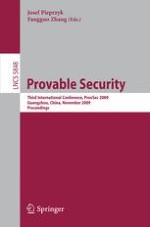2009 | Buch
Provable Security
Third International Conference, ProvSec 2009, Guangzhou, China, November 11-13, 2009. Proceedings
herausgegeben von: Josef Pieprzyk, Fangguo Zhang
Verlag: Springer Berlin Heidelberg
Buchreihe : Lecture Notes in Computer Science
